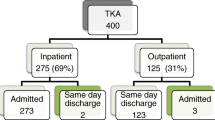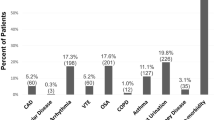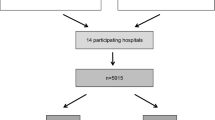Abstract
Purpose
There has been increasing interest in accelerated programs for knee arthroplasty. We examined the efficacy and safety of an outpatient surgery (OS) pathway in patients undergoing unicompartmental knee arthroplasty (UKA).
Methods
This case–controlled study evaluates patients operated for UKA in an OS pathway (n = 20) compared to rapid recovery (RR), the current standard (n = 20). We investigated whether patients could be discharged on the day of surgery, resulting in comparable or better outcome by means of adverse events (AEs) in terms of pain (numerical rating scale, NRS), incidences of postoperative nausea and vomiting (PONV) and opiate use (<48 h postoperatively), complication and readmission rates (<3 months postoperatively). Patient-reported outcome measures (PROMS) were obtained preoperatively and 3 months postoperatively.
Results
Postoperative pain (NRS > 5) was the most common reason for prolonged hospital stay in the OS pathway. Eighty-five per cent of the patients were discharged on the day of surgery, whereas 95 % of the patients were discharged on postoperative day 3 in the RR pathway. Overall, median pain scores in both pathways did not exceed a NRS score of 5, without significant differences (RR vs. OS) in the number of patients with PONV (4 vs. 2) and opiate use (11 vs. 9) <48 h postoperatively. At 3 months postoperatively, no significant differences were found for AEs and PROMS between both pathways.
Conclusion
The results of this study illustrates that an OS pathway for UKA is effective and safe with acceptable clinical outcome. Well-established and adequate standardized protocols, inclusion and exclusion criteria and a change in mindset for both the patient and the multidisciplinary team are the key factors for the implementation of an OS pathway.
Level of evidence
Case–control study, Level III.


Similar content being viewed by others
References
Andersen LØ, Husted H, Otte KS et al (2008) A compression bandage improves local infiltration analgesia in total knee arthroplasty. Acta Orthop 79(6):806–811
Backes JR, Bentley JC, Politi JR et al (2013) Dexamethasone reduces length of hospitalization and improves postoperative pain and nausea after total joint arthroplasty: a prospective, randomized controlled trial. J Arthroplasty 28(8 Suppl):11–17
Beard DJ, Murray DW, Rees JL et al (2002) Accelerated recovery for unicompartmental knee replacement—a feasibility study. Knee 9(3):221–224
Berger RA, Kusuma SK, Sanders SA et al (2009) The feasibility and perioperative complications of outpatient knee arthroplasty. Clin Orthop Relat Res 467(6):1443–1449
Berger RA, Sanders S, Gerlinger T et al (2005) Outpatient total knee arthroplasty with a minimally invasive technique. J Arthroplasty 20:33–38
Brooks R (1996) EuroQol: the current state of play. Health Policy 37(1):53–72
Cheung A, Lykostratis H, Holloway I (2014) Compression bandaging improves mobility following total knee replacement in an enhanced recovery setting. J Perioper Pract 24(4):84–86
Cross MB, Berger R (2014) Feasibility and safety of performing outpatient unicompartmental knee arthroplasty. Int Orthop 38(2):443–447
Del Pozo JL, Patel R (2009) Clinical Practice. Infection Associated with Prosthetic Joints. New Engl J Med 361:787–794
Dervin F, Madden SM, Crawford-Newton BA et al (2012) Outpatient unicompartment knee arthroplasty with indwelling femoral nerve catheter. J Arthroplasty 27(6):1159–1165
Essving P, Axelsson K, Åberg E et al (2011) Local infiltration analgesia versus intrathecal morphine for postoperative pain management after total knee arthroplasty: a randomized controlled trial. Anesth Analg 113(4):926–933
Essving P, Axelsson K, Kjellberg J et al (2009) Reduced hospital stay, morphine consumption, and pain intensity with local infiltration analgesia after unicompartmental knee arthroplasty. Acta Orthopaedica 80(2):213–219
Gondusky JS, Choi L, Khalaf N et al (2014) Day of Surgery Discharge after Unicompartmental Knee Arthroplasty: an Effective Perioperative Pathway. J Arthroplasty 29(3):516–519
Haverkamp D, Breugem SJ, Sierevelt IN et al (2005) Translation and validation of the Dutch version of the Oxford 12-item knee questionnaire for knee arthroplasty. Acta Orthop 76(3):347–352
Husted H, Holm G (2006) Fast-track in total hip and knee arthroplasty–experiences from Hvidovre University Hospital, Denmark. Injury 37(5):31–35
Husted H, Lunn HT, Troelsen A et al (2011) Why still in hospital after fast-track hip and knee arthroplasty? Acta Orthopaedica 82:679–684
Kehlet H, Andersen LØ (2011) Local infiltration analgesia in joint replacement: the evidence and recommendations for clinical practice. Acta Anaesthesiol Scand 55:778–784
Kehlet H, Dahl JB (2003) Anaesthesia, surgery, and challenges in postoperative recovery. Lancet 362:1921–1928
Kehlet H, Wilmore DW (2002) Multimodal strategies to improve surgical outcome. Am J Surg 183:630–641
Kehlet H, Wilmore DW (2008) Evidence-based surgical care and the evolution of fast-track surgery. Ann Surg 248:189–198
Kerr DR, Kohan L (2008) Local infiltration analgesia: a technique for the control of acute postoperative pain following knee and hip surgery. A case study of 325 patients. Acta Orthopaedica 79:174–183
Kolisek FR, McGrath MS, Jessup NM et al (2009) Comparison of outpatient versus inpatient total knee arthroplasty. Clin Orthop Relat Res 467(6):1438–1442
Losina E, Thornhill TS, Rome BN et al (2012) The dramatic increase in total knee replacement utilization rates in the United States cannot be fully explained by growth in population size and the obesity epidemic. J Bone Joint Surg Am 94(3):201–207
Lovald S, Ong K, Lau E et al (2014) Patient selection in outpatient and short-stay total knee arthroplasty. J Surg Orthop Adv 23(1):2–8
Munk S, Dalsgaard J, Bjerggaard K et al (2012) Early recovery after fast-track Oxford unicompartmental knee arthroplasty. 35 patients with minimal invasive surgery. Acta Orthopaedica 83(1):41–45
Ostendorf M, Johnell O, Malchau H et al (2002) The epidemiology of total hip replacement in The Netherlands and Sweden: present status and future needs. Acta Orthopaedica 73(3):282–286
Pearson SD, Goulart-Fisher D, Lee TH (1995) Critical pathways as a strategy for improving care: problems and potential. Ann Intern Med 123(12):941–948
Pilot P, Bogie R, Draijer WF et al (2006) Experience in the first four years of rapid recovery; is it safe? Injury 37(5):37–40
Price AJ, Webb J, Topf H et al (2001) Oxford Hip and Knee Group. Rapid recovery after oxford unicompartmental arthroplasty through a short incision. J Arthroplasty 16(8):970–976
Reilly KA, Beard DJ, Barker KL et al (2005) Efficacy of an accelerated recovery protocol for Oxford unicompartmental knee arthroplasty—a randomised controlled trial. Knee 12(5):351–357
Verma R, Alladi R, Jackson I et al (2011) Day case and short stay surgery: 2. Anesthesia 66:417–434
World Health Organization (2007) European observatory on health systems and policies; Day surgery: Make it happen
Wilmore DW, Kehlet H (2001) Management of patients in Fast-track surgery. BMJ 24(322):473–476
Zhang H, Chen J, Chen F et al (2012) The effect of tranexamic acid on blood loss and use of blood products in total knee arthroplasty: a meta-analysis. Knee Surg Sports Traumatol Arthrosc 20(9):1742–1752
Conflict of interest
One author (NK) is a payed consultant for Biomet on the Signature surgical procedure. The other authors declare that they have no conflict of interest. No financial support was received for this study.
Author information
Authors and Affiliations
Corresponding author
Rights and permissions
About this article
Cite this article
Kort, N.P., Bemelmans, Y.F.L. & Schotanus, M.G.M. Outpatient surgery for unicompartmental knee arthroplasty is effective and safe. Knee Surg Sports Traumatol Arthrosc 25, 2659–2667 (2017). https://doi.org/10.1007/s00167-015-3680-y
Received:
Accepted:
Published:
Issue Date:
DOI: https://doi.org/10.1007/s00167-015-3680-y




